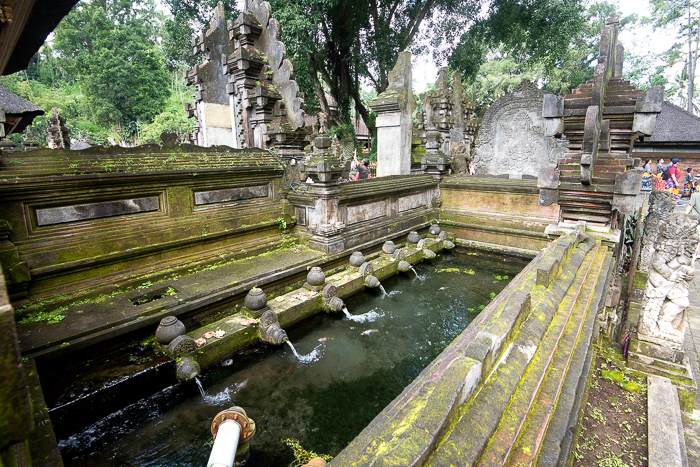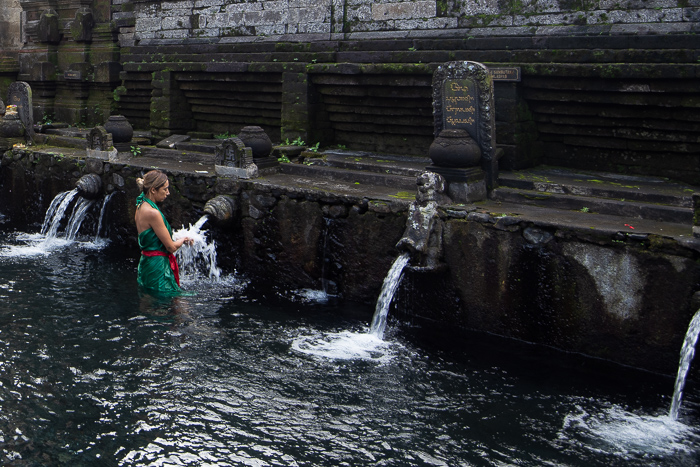Tirta Empul of Bali

Tirta Empul is a sacred bathing place that has served the Balinese faithful for well over a thousand years. Located in central Gianyar Regency, it stands along one of the sources of the Pakerisan River (the Keris River), which flows downstream toward Pura Mengening and Pura Gunung Kawi, both of which date to roughly the same period or perhaps a hundred years later.
It is among Bali’s most memorable monuments, notable for its vast rectangular bathing pool fed by numerous spouts—each providing streams of pure, clean water.The role of tirta, or holy water, is central to the Balinese religious experience.
As Kempers notes, “Holy Water is so important that it has given its name—agama tirtha, ‘Holy Water Relgion’—to the religion itself” (Kempers, p. 56). Davison remarks that tirtha is the primary method through which spiritual impurities are washed away into the sea.
The efficacy of a bathing place is intimately tied with the water’s place of origin, which ideally must come from a high mountain. While some sources incorrectly suggest that Tirta Empul is the headwaters of the Pakerisan river, its uppermost reaches begin along the southern slope of Mount Batur, the volcano adjacent to Mount Agung. The river runs some 45.2 kilometers, generally southward, with Tirta Empul roughly halfway along its length.
Along its path are at least 11 temples dating from the 11th century or earlier, suggesting that central Gianyar was an early site of Balinese civilization.
Legend
A mix of history and legend attests to the origins of Tirta Empul. On the historical side, the words Tirtha di(air) mpul may be found on the much-weatherworn stone now located on the grounds of the nearby Sakenan temple at Manukaya.
The stone, dated by Stutterheim and Goris to the years 884-962 and by Damais to 960, describes the site’s foundation by Sang ratu (Sri) Candra Bhya Singha Varmadeva and the construction of two ponds. Unfortunately, the stone is in very poor condition, and it has not been fully or reliably deciphered.

Kempers notes that Stutterheim observed that locals would bathe the stone regularly on the full moon of Kartika (the fourth month), possibly resulting in the stone’s worn condition. Curiously, the stone itself mentions the same ritual, as the full moon of Kartika coincides with Tirta Empul’s founding.
Tirta Empul creation myth
Another, Myth of Mayadenawa offers a metaphysical explanation for Tirta Empul’s creation.
Mayadenawa was the scion of a noble line of kings who grew infatuated with the occult arts, learning to transform himself into various forms and even to make himself appear invisible. As he arrogated more and more authority and grew ever more adept in his magic, he believed himself equal to the gods.
He forbade the Balinese people to attend religious festivals and began destroying temples across the island. For these deeds, he quickly grew to be hated by both the local population and the priestly authorities.
With their temples closed or destroyed, the people were unable to call upon the gods to intercede with their blessings. As a result, crops turned to dust, rodents swarmed the ground, rivers dried up, and plague stalked the land. In time, the powerful Hindu priest Mpu Kulputih secretly went to Besakih temple to ask the gods to intervene.
They responded by sending a battalion of soldiers led by the god Indra, who descended to earth and engaged Mayadenawa and his armies on the field of battle.At first, Indra’s contingent seemed to gain the upper hand, as they were much stronger than Mayadenawa’s forces. However, as night fell, the battle halted as neither army could see one another. Indra ordered his soldier to camp for the night, where they slept in preparation for the final assault the coming morning.

Realizing this was his only chance, Mayadenawa snuck into the camp and used his magical powers to generate a great pool of water, into which he dumped poison. To avoid leaving any traces, he walked out of camp, balancing on the sides of his feet.
For that reason, the area is still called Tampak Siring, which means “edge of the footprints.”At dawn, Indra’s army awoke and satisfied their thirst by drinking from the poisoned water. As his soldiers all fell sick, Indra realized something was wrong with their water supply.
As an antidote, he used his supernatural abilities to call forth a fresh, sweet spring, which gushed from the ground. Indra’s armies fell upon the water, which purified them as it flushed out the poison. Today, this spring is called Tirta Empul.
With their vigor restored, Indra’s armies routed Mayadenawa’s forces, sending him into hiding. Mayadenawa attempted to escape by turning himself into various creatures and objects, finally settling upon the form of a rock.
However, Indra saw through the ruse and shot Mayadenawa (still in the guise of a rock), killing him. Mayadenawa’s poisoned blood, however, flowed into a nearby ravine, forming the path of the Pakerisan river.
Indra then laid a curse upon the stream, warning that the river water, if used for growing rice, would appear to work well. But, he cautioned that any rice harvested would weep blood and smell like a decaying corpse.


